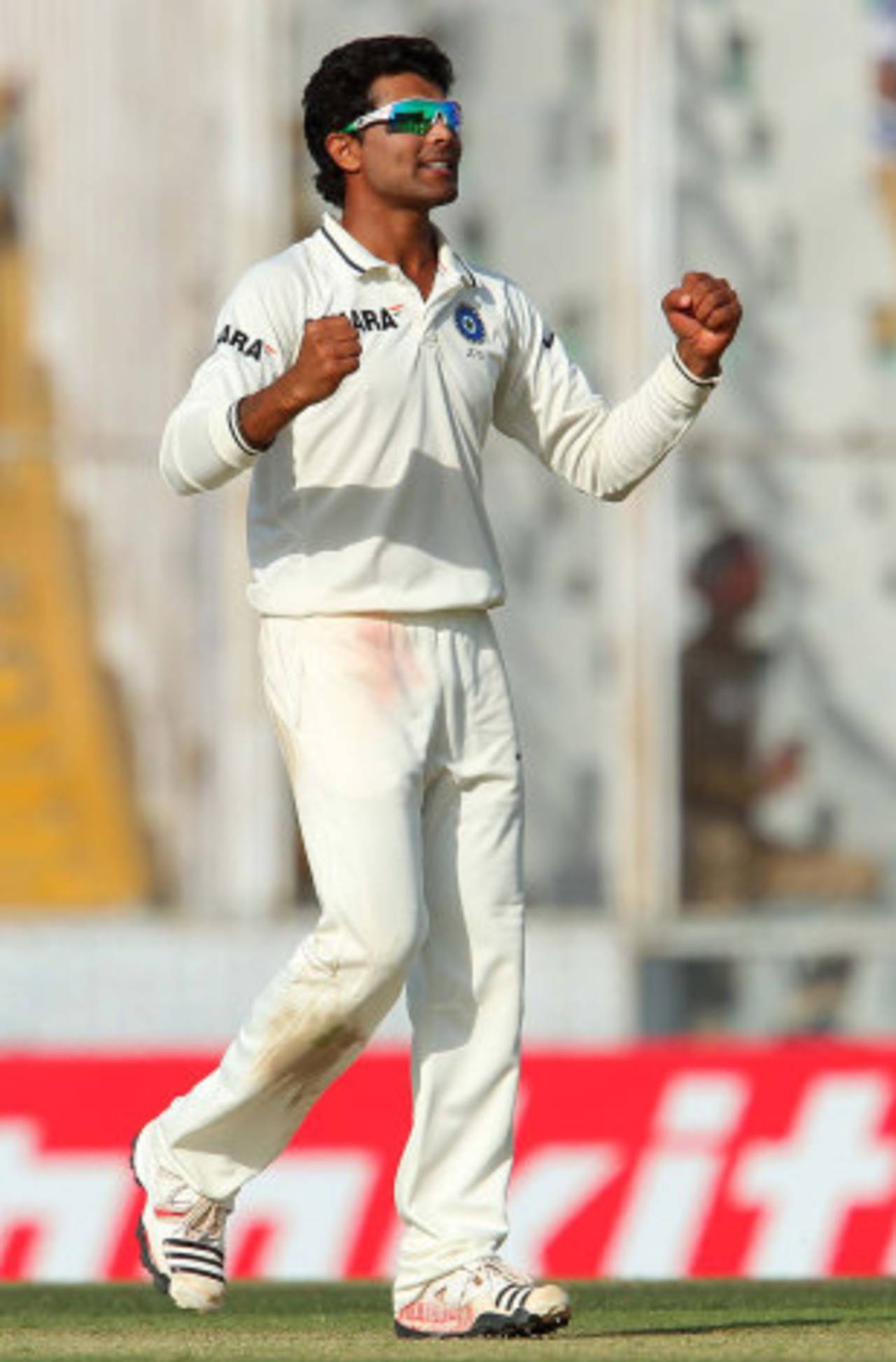Mohali pitch presents alternative reality
Though the final scoreline followed the familiar script, the pitch and the performers during the first day in Mohali were distinctly different from the rest of the series
Sharda Ugra
15-Mar-2013

The leader of India's spin trio was neither R Ashwin or Pragyan Ojha, but it was the third spinner, Ravindra Jadeja • BCCI
On Friday, Mohali belonged to a parallel universe. The PCA Stadium looked like what it always does, the eventual scoreline at stumps was like what has been in the series so far, but in between the first ball and the last, much was turned on its head. In appearance itself, the pitch best known to Punjab and India's cricketers, had transmogrified into an alien grasslessness. In keeping with it, the performances of the teams also witnessed significant alterations.
Mohali's reputation as a utopia for seamers has rightly been diminishing, but this season Punjab have won four out of four home Ranji Trophy matches outright. Ten of 14 first-class innings played in Mohali this season have not gone beyond 260. What Australia's batsmen found though was a welcome personality switch. On the best batting wicket of the tour, they chose to approach the innings as if this were not their fifth innings in India, but their first. With caution, with circumspection, without open declarations of 'positivity.' It may have produced the best opening stand of their tour so far - 139 - the day ended for Australia at 273 for 7. Day 1 in Chennai remains their best day of the tour, but even there, 380 was to be inadequate.
Like they have been all series, India's spinners were in play, but the leader of the pack on Friday was unforeseen. It wasn't the tall, sun-glassed, haughty offspinner with his corkscrew yo-watch-my-revs action. It wasn't the chubby-faced left-arm spinner who finally got a game, but had few chances to make some of his famous finger-waggling appeals. The main man was India's third-change spinner instead, curly mop over green sunglasses to the offspinner's red and Twenty20 reputation in sudden shape-shift, on a wicket not meant to serve his brand of bowling.
More followed. The single Australian middle order man to get past fifty was the last man in to the XI due to the benching of four others. The guy behind the benching, Australia's captain and best batsman, only lasted one ball. His intent morphed into braggadocio and his quicksilver feet were found stuck in quicksand. Surely not of the kind he and his management had drawn a line in, a few days ago.
The final sign of the altered reality came when India's reedy strike bowler took two wickets in three balls in the 94th over of the day. He was bowling with a ball that was so tattered and worn that ten minutes later the umpires were forced to change it.
All around the baffling unpredictability, the script of the 2013 India v Australia series stayed the way India would want it. There will be much delight in how the day panned out because India's bowlers were able to make the most of a wicket that bore little resemblance to the beasts offered up in Chennai and Hyderbad. That they were able to cut through Australia's batting line-up - two wickets at a time - is all the evidence they need of its fragility.
R Ashwin pulled out a full repertoire of conventional offspin, with the rare carrom-ball and variations of pace and Pragyan Ojha took some time to find a line that could ask questions. India's go-to bowler, however, ended up being the man who was the last in the attack. Ravindra Jadeja was brought on a little under half an hour before lunch and bowled a ten-over spell on either side of the break. His ability to nag and probe, asking the batsmen to make the play had an effect that was not instant but produced impact that was to reverberate through the rest of the day.
In the morning, there was little turn and few moments of variable bounce. But in Jadeja's tenth over, plenty happened. One shot through at ankle height for Cowan and two balls later, Warner stepped out, but had the delivery jump up a little and nibble at bat and pad to offer a juicy lob in front of him. Dhoni came racing from behind the batsman to take the catch. Off the very next ball, Michael Clarke, at No. 3 for the second time in his career, fell back on his template against spinners - Operation Domination. He stepped out to Jadeja bowling one at 90kph, watched the ball turn past his bat and reach Dhoni before he could blink.
Jadeja didn't get his hat-trick but he had set Australia onto a nervous wobble that turned into the dismissal of Phillip Hughes 12 runs and 69 balls later. India were able to press forward, despite Steven Smith's handsome unbeaten effort, with Ashwin and Ojha picking up a wicket each. Ishant made the most of being able to reverse the old worn-out ball, bowling two batsmen in his 18th over of the day.
India's bowling today was soaked in sweat and toil, rather than being dependent on the pitch and batsmen's ineptitude. The Mohali pitch is said to contain a higher degree of clay content. It binds together particularly well, helps keep the grass alive and in theory, is meant to assist seam movement. When left to dry, it doesn't crumble into powder like red-soil pitches. When it comes apart, it does like Australia's batting has this series. In clumps.
Sharda Ugra is senior editor at ESPNcricinfo